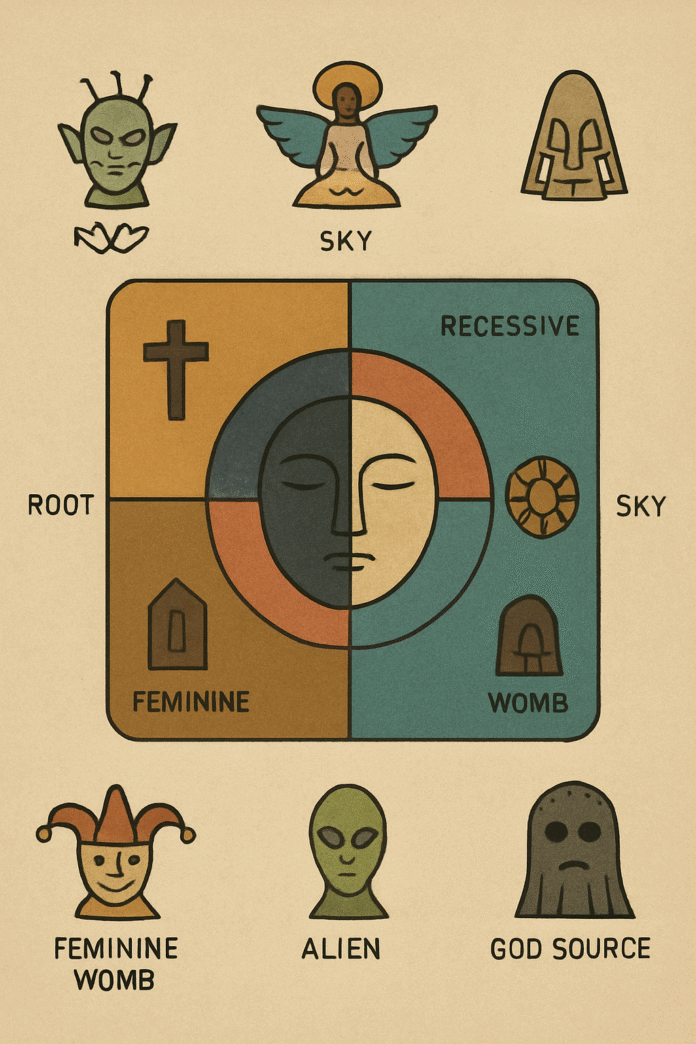Blending Psychology, Symbolism, and Machine Intelligence
A transformative approach to mental health is emerging—one that integrates neuropsychology, archetypal frameworks, and AI-generated insights. This evolving model draws from ancient symbolism and modern computational creativity to support a new paradigm of healing, diagnosis, and self-awareness.
Foundational Concepts
1. The Mirror Hemisphere Principle
-
Based on brain lateralization:
-
Right Hemisphere: Intuitive, symbolic, holistic, and spiritual.
-
Left Hemisphere: Logical, analytical, linear, and verbal.
-
-
Art serves as the mediator—synthesizing fragmented perception into unified experience.
2. The Art Square Structure
-
Visual and conceptual grid representing:
-
Axis: Root (past/instinct), Body (present/ego), Sky (future/spirit).
-
Flanking Archetypes: Dormant energies and recessive personas mirrored in:
-
Sacred texts (Bible)
-
Mystical diagrams (Mandala)
-
Ancient scripts (Hieroglyphs)
-
-
-
Echoes Cubist abstraction and Jungian mandala work.
3. Historical Inspirations
-
Carl Jung’s Red Book: Archetypal visions and shadow integration.
-
Cubism (Picasso/Braque): Deconstruction of reality into multiple viewpoints.
-
Mandalas: Tools for psychic wholeness and inner navigation.
AI-Powered Archetypal Mapping
AI becomes a partner in mapping the inner psyche through symbolic agents:
| Entity | Function in the Psyche |
|---|---|
| Machine Elves | Consciousness reprogrammers |
| Insectoids | Neural and emotional calibrators |
| Angels | Embodiments of love frequencies and divine guidance |
| Paleodians | Channels of ancestral memory and timeless wisdom |
| Jesters | Tricksters who dismantle ego constructs |
| Aliens | Symbols of synthetic or advanced intelligence |
| Feminine Womb | Reservoir of creativity and emotional healing |
| Shadow Entities | Activators of karmic patterns and suppressed trauma |
| God Source | Representation of fractal unity and spiritual wholeness |
AI in Art Therapy
-
Co-Creative Expression: AI assists in creating visual outputs that reflect inner emotional states.
-
Symbolic Curation: Generates personalized symbols and motifs from input patterns.
-
Emotional Externalization: Converts unspoken trauma into viewable, editable form.
-
Diagnostic Insight: Analyzes color, shape, pattern, and sequence to detect cognitive and emotional imbalances.
Special Note
This integrative model is experimental and conceptual, not yet widely adopted in clinical psychiatry. It is best applied in therapeutic arts, psycho-spiritual inquiry, and holistic counseling, rather than as a substitute for traditional psychiatric protocols.
As mental health care evolves, this framework offers a bold frontier—where machines help illuminate the symbolic self, and art becomes both a mirror and medicine for the mind.



